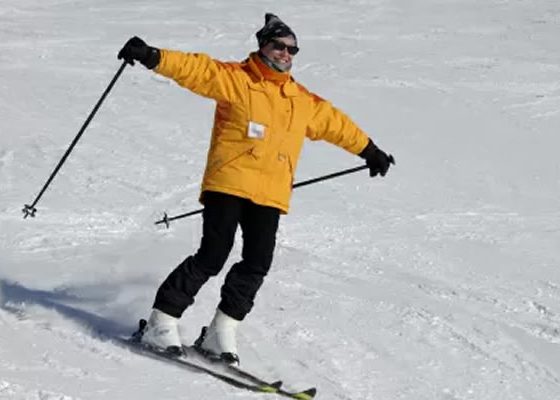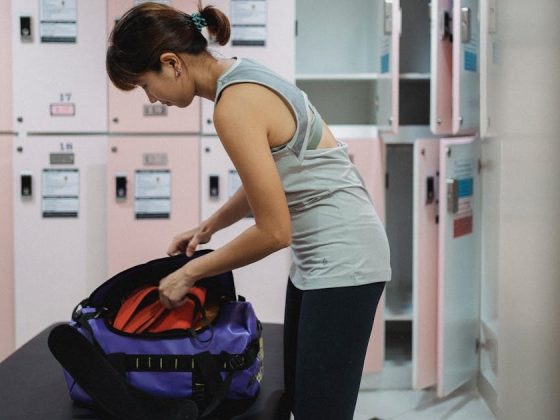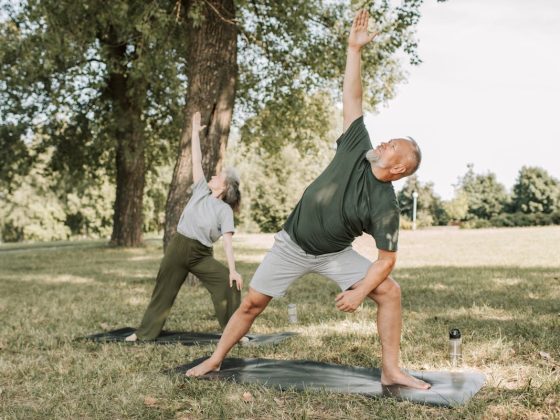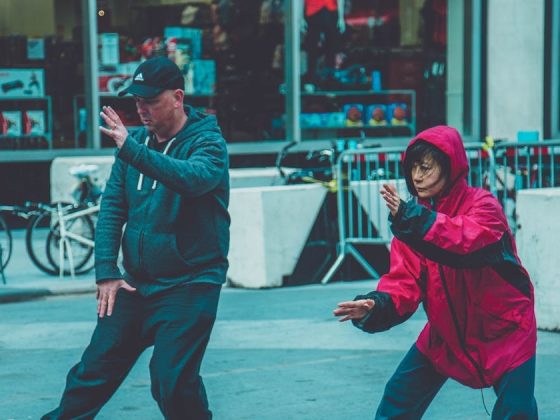Tai chi exercise is a gentle way for anyone to engage not only their body, but also their mind. Unlike high-impact activities like running or high intensity aerobics, tai chi will help energize practitioners in a relaxing and calming way.
Basic Tai Chi Moves
Tai Chi is meant to be done as a slow, fluid exercise. It isn’t a matter of “doing a move” and then you’re done. Instead, the moves are incorporated into full forms within the practice. Following are some basic tai chi moves you will likely encounter in a group class or when following a practitioner’s instructions online.
Rise and Fall
An introductory move, the Rise and Fall often begins a tai chi session. This is also called a “prayer wheel.”
- Stand tall and grounded with feet about shoulder-width apart and shoulders relaxed. Knees are soft.
- Place your hands in front of you with palms down and elbows bent – your hands should be below your waist and fingers should be relaxed.
- Inhaling, bring the arms up. Palms still face down, and fingers are still relaxed.
- When your hands are overhead, begin the exhale slowly.
- Your hands will slowly and fluidly return to their beginning position as you conclude the full exhale.
Hold the Ball
The name of this move describes the move quite well – people doing this move appear to be holding a large ball as they work through the sequence.
- Place feet around shoulder-width apart. Keep your knees soft and your body tall.
- Inhale. Slowly and fluidly bring your arms up to around shoulder height, palms facing inward as if you are holding a large ball in front of you.
- Hold this posture and continue breathing deeply. Keep your elbows and knees soft and your shoulders relaxed.
- This is a posture of stillness – close your eyes and hold the pose for as long as you can maintain proper posture.
Ward Off Right
This flowing movement gets the entire body involved and should be done gently and slowly. Keep your body relaxed and don’t stiffen your muscles.
- Standing upright, put your weight into your left leg while bringing up the right heel.
- Shift your waist toward the right.
- Use your hands to form a ball with your left hand on top (hands don’t touch).
- Drop your right heel.
- Shift your weight to your right leg.
- Raise your right hand with your palm facing your chest until it is chest-height. Aim for your arms to feel as though they are weightless as you move.
- The left arm follows the turn at waist-height before meeting with the right arm with both palms facing each others.
Repulse Monkey
This move is from the Yang style of Tai Chi and is typically used as a transition move within a sequence.
- Step your left foot forward, putting your weight into your toes.
- Soften your knees into a bend.
- Gently turn your upper body to the right.
- With palms facing outward, slowly push your hands in front of you.
- In a circular motion, move your right hand down and back.
- Bring your right hand up behind your right ear and push your palm forward.
- Repeat the sequence, switching your right for your left.
Tai Chi Benefits
There are a number of benefits to tai chi exercise. It’s a low-impact way to get moving while also increasing balance and stability. Most people find the meditative properties of tai chi to be most beneficial.
No Equipment
This is a highly portable exercise program, as no special equipment is needed. You can do tai chi just about anywhere; this includes inside or outdoors. For people who travel frequently, tai chi is a wonderful way to practice a relaxing exercise program on the road.
Improves Coordination
As you perform tai chi, your body flows through a series of movements, which look almost like a slow dance. You focus on breathing and slowly controlling your movements. This focus on maintaining the correct posture and balance can help people become more physically aware and coordinated.
Good for Anyone
People who suffer from arthritis or are very overweight often find it difficult to take part in exercise. They are not excluded, however, from tai chi, as the movements can usually be performed by anyone, regardless of the shape they’re in.
Reduces Stress
Just 15 minutes of tai chi per day can help reduce stress levels. Because increased stress often leads to other health problems, tai chi may help to avoid serious issues due to a stressful lifestyle.
Good for Weight Loss?
Although tai chi offers users several benefits, it’s important to note that tai chi is not a high calorie burner and therefore not the best activity for people seeking to lose large amounts of weight. Anyone looking to drop pounds should engage in a more vigorous form of cardio activity, such as walking, hiking, jogging, skiing, cycling or using an elliptical in conjunction with dietary changes.
Calming Exercise
Add tai chi to your daily activities as a calming way to either energize your body and mind, or to wind down after a busy day. Some people will find that the mind-body connection that tai chi encourages forces them to think more deeply about what they eat. They may follow a healthier eating plan, and therefore lose weight as a direct result of practicing this ancient exercise.
Lower Stress Hormones
Any activity that lowers stress has the potential to lower the stress hormone cortisol – this hormone can lead to weight gain (particularly in the belly area). Lowering your stress through the meditative practice of Tai Chi can help kick-start your weight loss by reducing the cortisol levels within your body.
Gentle Fitness
It’s energizing while also being relaxing, it accommodates beginners and experts alike, and it relieves stress while not stressing the body – tai chi seems to have it all. Whether pre-existing conditions restrict the types of activities you can do and tai chi is perfect for that reason, or you’re looking for a portable workout that you can perform anywhere, this old form of exercise can easily be added to your daily routine.





